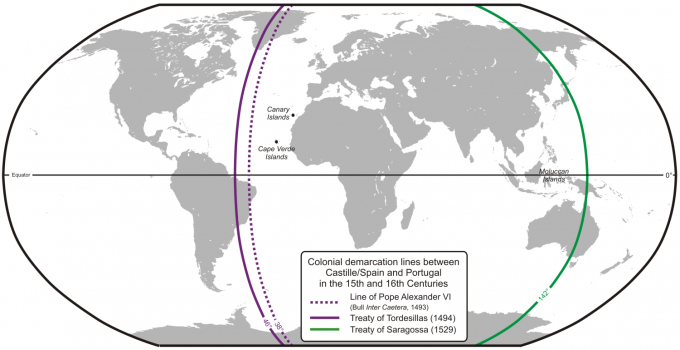The Treaty of Tordesillas: Resolving "a Certain Controversy" over Land in the Americas
by Elizabeth Berlin Taylor
Background
Imperial rivalries have often been resolved through war; however, the Treaty of Tordesillas is an important example of a rivalry that was resolved without hostilities through the demarcation of areas of influence by the Catholic Church. The Treaty of Tordesillas successfully arbitrated which lands could be ruled by Spain and which could be ruled by Portugal by creating a boundary "three hundred and seventy leagues west of the Cape Verde Islands." This line ran from the North to South Poles. Any lands discovered to the east of the line would be ruled by Portugal and lands to the west of the 1494 "Line of Demarcation" would be ruled by Spain. The Treaty was largely respected, though Brazil does extend past the line, and had important consequences in establishing the Portuguese colony of Brazil and the Spanish areas of influence to the west. It successfully prevented violence between the two Iberian nations and demonstrated the importance of the Church in the expansion of empires and the rivalries between them.
Essential Question
How did the Treaty of Tordesillas peacefully divide the Americas between Spain and Portugal?
Learning Objectives
- Read and analyze the original translated text of the Treaty of Tordesillas
- Work with a group to answer questions about a primary source
- Engage in a productive whole-class discussion
- Create thesis statements that can be proven using the Treaty of Tordesillas
- Work with a group to create an outline that proves a thesis about the Treaty of Tordesillas
Introduction

Project the map that shows the Treaty of Tordesillas. Download the map of the Treaty of Tordesillas here (PDF).
Ask students:
- What do you think the two Lines of Demarcation separate?
- How were they decided upon?
- Why do you think the line on right was established after the two lines to the left?
Go over student responses asking further questions like, what country is on the right side of the Line of Demarcation of 1494 and what languages are spoken on either side of that line. By the end of this discussion, students should begin to understand that the Lines of Demarcation separate the Spanish and Portuguese empires in the Americas.
Procedure
- Divide students into six groups, each of which will analyze one section of the Treaty of Tordesillas, 1494.
- Students will read excerpts from the Treaty of Tordesillas and answer brief questions to help them analyze the document.
- Students will share their answers with the whole class.
- The class as a whole will then come up with three thesis statements about the Treaty of Tordesillas. These arguments should be one sentence in length, and students should feel that they can prove these statements by using quotations and information from the document. Teachers should project these three statements so that they remain visible as students proceed with the lesson.
- Students will return to their original six groups. In each group, students will choose one of the three thesis statements. Students will work together to create one illustrated outline that proves the thesis statement. (If the teacher prefers, new groups could also be created that contain one member from each of the original six groups, as those students will have different areas of expertise with the Treaty). Students should be provided with the entire text of the treaty to complete this activity.
Conclusion
Student groups will come up with a more descriptive name for the Treaty of Tordesillas, one that would give future students more of an understanding of what the Treaty does.
